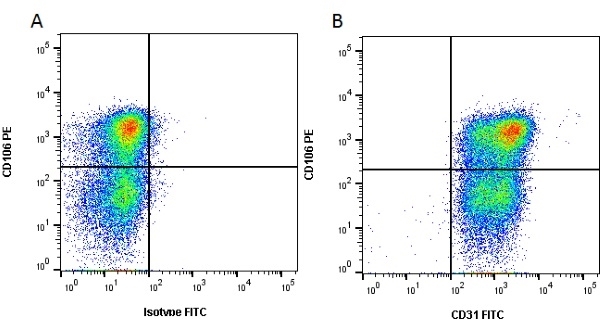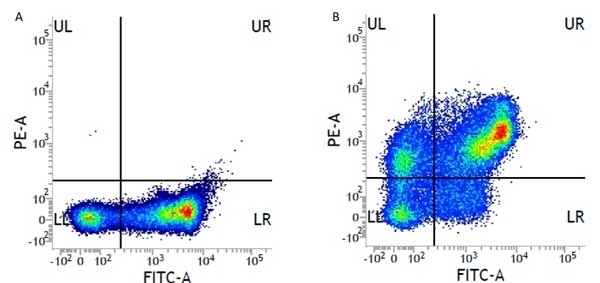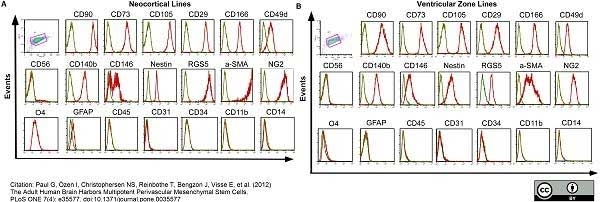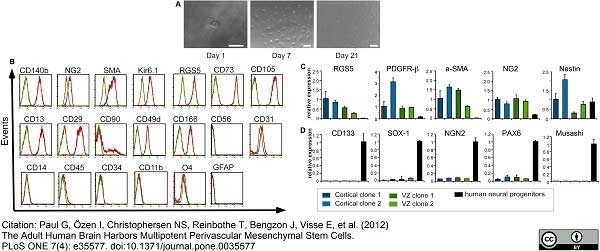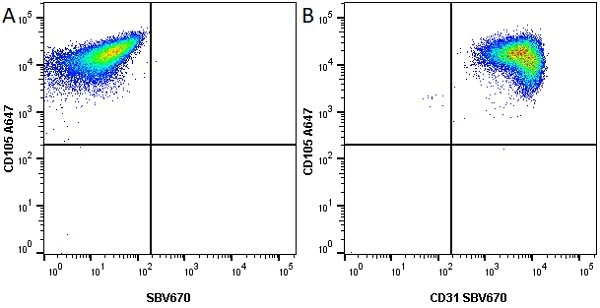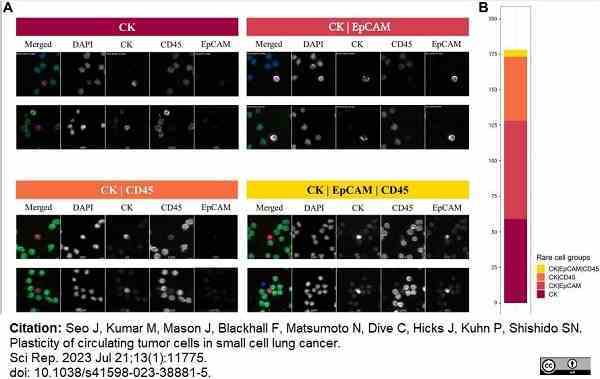CD31 antibody | WM59















































Mouse anti Human CD31:StarBright Violet 670
- Product Type
- Monoclonal Antibody
- Clone
- WM59
- Isotype
- IgG1
- Specificity
- CD31
| Mouse anti Human CD31 monoclonal antibody, clone WM59 recognizes the human CD31 antigen, a ~130 kDa single pass type I transmembrane glycoprotein bearing six C2 immunoglobulin domains. CD31 is expressed by all continuous endothelia including arteries, veins and non-sinusoidal capillaries, platelets,granulocytes and some lymphocytes. CD31 is not expressed by discontinuous endothelia such as hepatic sinusoids and splenic red pulp (Muller et al. 1989).CD31 is also known as PECAM-1. The binding epitope for mouse anti human CD31, clone WM59 has been mapped to the Ig-like domain 2 (Fawcett et al. 1995). |
- Target Species
- Human
- Species Cross-Reactivity
-
Target Species Cross Reactivity Cynomolgus monkey Rhesus Monkey - N.B. Antibody reactivity and working conditions may vary between species.
- Product Form
- Purified IgG conjugated to StarBright Violet 670 - liquid
- Preparation
- Purified IgG prepared by affinity chromatography on Protein A from tissue culture supernatant
- Buffer Solution
- Phosphate buffered saline
- Preservative Stabilisers
- 0.09% Sodium Azide (NaN3)
1% Bovine Serum Albumin
0.1% Pluronic F68
0.1% PEG 3350
0.05% Tween 20 - Max Ex/Em
-
Fluorophore Excitation Max (nm) Emission Max (nm) StarBright Violet 670 401 667 - Regulatory
- For research purposes only
- Guarantee
- 12 months from date of despatch
- Acknowledgements
- This product is covered by U.S. Patent No. 10,150,841 and related U.S. and foreign counterparts
This product should be stored undiluted.
| Application Name | Verified | Min Dilution | Max Dilution |
|---|---|---|---|
| Flow Cytometry | Neat |
- Flow Cytometry
- Use 5μl of the suggested working dilution to label 106 cells in 100μl. Best practices suggest a 5 minutes centrifugation at 6,000g prior to sample application.
How to Use the Spectraviewer
Watch the Tool Tutorial Video ▸- Start by selecting the application you are interested in, with the option to select an instrument from the drop down menu or create a customized instrument
- Select the fluorophores or fluorescent proteins you want to include in your panel to check compatibility
- Select the lasers and filters you wish to include
- Select combined or multi-laser view to visualize the spectra
| Description | Product Code | Applications | Pack Size | List Price | Your Price | Quantity | |
|---|---|---|---|---|---|---|---|
| Human Seroblock | BUF070A | F | 50 Test | Log in | |||
| List Price | Your Price | ||||||
| Log in | |||||||
| Description | Human Seroblock | ||||||
| Human Seroblock | BUF070B | F | 200 Test | Log in | |||
| List Price | Your Price | ||||||
| Log in | |||||||
| Description | Human Seroblock | ||||||
References for CD31 antibody
-
Paul, G. et al. (2012) The adult human brain harbors multipotent perivascular mesenchymal stem cells.
PLoS One. 7: e35577. -
Urquhart, P. et al. (2007) Carbon monoxide-releasing molecules modulate leukocyte-endothelial interactions under flow.
J Pharmacol Exp Ther. 321 (2): 656-62. -
Reedquist, K.A. et al. (2000) The small GTPase, Rap1, mediates CD31-induced integrin adhesion.
J Cell Biol. 148: 1151-8. -
Vernon-Wilson, E.F. et al. (2007) CD31 delays phagocyte membrane repolarization to promote efficient binding of apoptotic cells.
J Leukoc Biol. 82: 1278-88. -
Hilbe W et al. (2003) Immunohistochemical typing of non-small cell lung cancer on cryostat sections: correlation with clinical parameters and prognosis.
J Clin Pathol. 56 (10): 736-41. -
Stein, A. et al. (2010) Local erythropoietin and endothelial progenitor cells improve regional cardiac function in acute myocardial infarction.
BMC Cardiovasc Disord. Sep; 10:43. -
Woollard, K.J. et al. (2002) Direct modulatory effect of C-reactive protein on primary human monocyte adhesion to human endothelial cells.
Clin Exp Immunol. 130: 256-62. -
Theberge, A.B. et al. (2015) Microfluidic multiculture assay to analyze biomolecular signaling in angiogenesis.
Anal Chem. 87 (6): 3239-46.
View The Latest Product References
-
Hilbe W et al. (2004) CD133 positive endothelial progenitor cells contribute to the tumour vasculature in non-small cell lung cancer.
J Clin Pathol. 57 (9): 965-9. -
Palakkan, A.A. et al. (2015) Polarisation and functional characterisation of hepatocytes derived from human embryonic and mesenchymal stem cells.
Biomed Rep. 3 (5): 626-636. -
Newey SE et al. (2014) The hematopoietic chemokine CXCL12 promotes integration of human endothelial colony forming cell-derived cells into immature vessel networks.
Stem Cells Dev. 23 (22): 2730-43. -
Fabre-Mersseman V et al. (2011) CD4⁺ recent thymic emigrants are infected by HIV in vivo, implication for pathogenesis.
AIDS. 25 (9): 1153-62. -
Patten PE et al. (2008) CD38 expression in chronic lymphocytic leukemia is regulated by the tumor microenvironment.
Blood. 111 (10): 5173-81. -
Katz SC et al. (2004) Liver sinusoidal endothelial cells are insufficient to activate T cells.
J Immunol. 173 (1): 230-5. -
Pfisterer K et al. (2015) CD90(+) human dermal stromal cells are potent inducers of FoxP3(+) regulatory T cells.
J Invest Dermatol. 135 (1): 130-41. -
Hale, S.J. et al. (2015) CXCR2 modulates bone marrow vascular repair and haematopoietic recovery post-transplant.
Br J Haematol. 169 (4): 552-64. -
Muthana, M. et al. (2015) Directing cell therapy to anatomic target sites in vivo with magnetic resonance targeting.
Nat Commun. 6: 8009. -
Schuster, C. et al. (2015) Development of Blood and Lymphatic Endothelial Cells in Embryonic and Fetal Human Skin.
Am J Pathol. 185 (9): 2563-74. -
Somers, E. et al. (2016) Vascular Defects and Spinal Cord Hypoxia in Spinal Muscular Atrophy.
Ann Neurol. 79 (2): 217-30. -
Soh, B.S. et al. (2016) Endothelin-1 supports clonal derivation and expansion of cardiovascular progenitors derived from human embryonic stem cells.
Nat Commun. 7: 10774. -
GarikipatiV, N.S. et al. (2018) Isolation and characterization of mesenchymal stem cells from human fetus heart.
PLoS One. 13 (2): e0192244. -
Duque, J.C. et al. (2019) Vascularization of the arteriovenous fistula wall and association with maturation outcomes.
J Vasc Access. : 1129729819863584. [Epub ahead of print] -
Kim, J.S. et al. (2021) Randomization to Omega-3 Fatty Acid Supplementation and Endothelial Function in COPD: The COD-Fish Randomized Controlled Trial.
Chronic Obstr Pulm Dis. 8(1): 41-53. -
Bye, A.P. et al. (2018) Immobilization of Nonactivated Unfixed Platelets for Real-Time Single-Cell Analysis.
Methods Mol Biol. 1812: 1-11. -
Chai, S. et al. (2022) Identification of epithelial and mesenchymal circulating tumor cells in clonal lineage of an aggressive prostate cancer case.
NPJ Precis Oncol. 6 (1): 41. -
Bettin, L. et al. (2023) Co-stimulation by TLR7/8 ligand R848 modulates IFN-γ production of porcine γδ T cells in a microenvironment-dependent manner.
Dev Comp Immunol. 138: 104543. -
Seo, J. et al. (2023) Plasticity of circulating tumor cells in small cell lung cancer.
Sci Rep. 13 (1): 11775. -
Shishido, S.N. et al. (2024) Cancer-related cells and oncosomes in the liquid biopsy of pancreatic cancer patients undergoing surgery.
NPJ Precis Oncol. 8 (1): 36. -
Bai, L. et al. (2024) Longitudinal tracking of circulating rare events in the liquid biopsy of stage III-IV non-small cell lung cancer patients.
Discov Oncol. 15 (1): 142.
Further Reading
-
DeLisser, H.M. et al. (1994) Molecular and functional aspects of PECAM-1/CD31.
Immunol Today. 15 (10): 490-5.
MCA1738SBV670
If you cannot find the batch/lot you are looking for please contact our technical support team for assistance.
Please Note: All Products are "FOR RESEARCH PURPOSES ONLY"
View all Anti-Human ProductsAlways be the first to know.
When we launch new products and resources to help you achieve more in the lab.
Yes, sign me up


